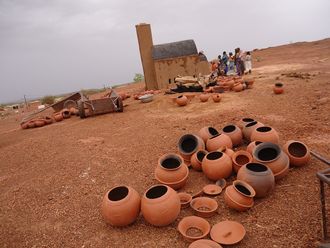BALTIMORE: For health care workers on the front lines of the Ebola epidemic in West Africa, risking their lives in stifling protective suits, relief could soon be on the way.
Researchers at Johns Hopkins University have developed a new-style outfit that is not only more comfortable, but also less likely to accidentally infect its users.
Conceived during a weekend hackathon in October, it has just won funding from the US Agency for International Development (USAID), lifting hopes it could be in production and out in the field in a matter of months.
“I don’t want to say this is a profound revolution in PPE (personal protective equipment) suits,” professor Youseph Yazdi, director of the university’s Centre for Bioengineering Innovation and Design, told AFP.
“But you don’t want rocket science. You want simple improvements that can actually save lives, have an impact on health and safety ... but get to the field quick,” he said alongside a bright yellow prototype mounted on a mannequin in the centre’s open-plan design studio.
Ebola, one of the deadliest viruses known to man, spreads through direct contact with the bodily fluids of an infected person — and those who care for the sick are especiallly vulnerable.
Of the nearly 7,000 people who have so far died of Ebola, at least 365 were healthcare workers, the World Health Organization said this week.
Existing protective suits help, but they suffer from shortfalls that the Johns Hopkins team — a diverse group of about 80 that included doctors, engineers, technicians, even a Baltimore wedding gown designer — set out to identify and correct. They started with the zipper.
Typically it’s at the front — the side of a protective suit most likely to be splattered with toxic bodily fluids, and close to the nose and mouth areas.
“It is the doffing [of a suit] that has a lot of risk,” said Willibrord Shasha, a doctor with Jhpiego, a non-profit John Hopkins affiliate that introduces health care innovation into developing countries.
The new suit opens at the back. Reach behind the shoulders, grab a pair of tabs behind the shoulders, then bend over fully to the floor and step on the tabs.
As the back zip opens, the suit begins to peel itself off, falling onto the floor with minimal intervention by the wearer, ready for safe disposal.
Improved ventilation and comfort comes from a novel belt-mounted dry air device.
About the size of a large paperback novel, it consists of a desiccant canister and a small fan, connected to the hood with a plastic tube.
“I’ve tried it on myself in a simulation room [at Under Armour, the Baltimore-based sportswear brand] set at the same conditions as in West Africa, close to 135 degrees [57 Celsius] heat index,” Yazdi said.
“You put the suit on, and within like a minute you feel like you are going to suffocate ... but then, when this dry air is blowing in, even though it’s hot dry air, it’s a huge relief.”
Another simple but significant variation is the size of the clear face visor. It’s huge, enabling Ebola sufferers to get a full view of their caregivers, relate more easily with them and feel reassured.
“I think it will make a lot of people go to hospitals and health centres, because they’ll know their own people are treating them, not aliens,” said Shasha, a Cameroon native who has worked throughout West Africa.
The suit is made of Tyvek, a DuPont synthetic fabric already widely used for industrial coveralls, heavy-duty mailing envelopes and weather-resistant “housewrap” for buildings under construction.
“It resists tearing, it resists liquid penetration so you don’t get any splashes going in, but it also breathes, so it does have some degree of comfort,” Yazdi said.
Johns Hopkins has already been contacted by manufacturers of existing PPE suits keen to make the new outfit — and Yazdi said they would be best placed to do so.
“The speed at which these things get implemented and delivered to the field depends a lot on partnerships with companies that already makes [protective] suits,” he said.
As for price, Yazdi expects the new suit should cost the same, if not fractionally more, than current suits, which typically sell for $12(Dh44) to $17 apiece.
And because it should be more comfortable, those who don them could wind up wearing them for longer periods at a time than existing models — a saving over the long run.












